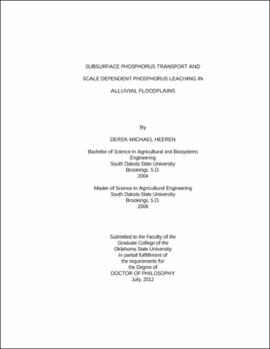| dc.contributor.advisor | Fox, Garey A. | |
| dc.contributor.author | Heeren, Derek Michael | |
| dc.date.accessioned | 2013-11-26T07:43:14Z | |
| dc.date.available | 2013-11-26T07:43:14Z | |
| dc.date.issued | 2012-07 | |
| dc.identifier.uri | https://hdl.handle.net/11244/6411 | |
| dc.description.abstract | Scope and Method of Study: | |
| dc.description.abstract | Scientists and engineers need to identify critical nutrient source areas and transport mechanisms within a catchment in order to cost effectively protect and enhance drinking water systems, recreation activities, and aquatic ecosystems. The objective of this research was to characterize phosphorus (P) leaching through the vadose zone and subsurface transport through coarse gravel subsoils to streams. An aquifer injection test, long term monitoring of water table elevation and P, and infiltration experiments were performed in the Ozark ecoregion of Oklahoma and Arkansas. A berm method was developed in order to quantify infiltration and P leaching at the plot scale. | |
| dc.description.abstract | Findings and Conclusions: | |
| dc.description.abstract | The injection test showed preferential flow paths and physical non-equilibrium in the coarse gravel vadose and phreatic zones. Preferential flow paths were interpreted to be buried gravel bars. Long-term flow and transport monitoring of alluvial aquifers showed aquifer heterogeneity and large scale bank storage of stream water, as well as large scale, stage-dependent transient storage of P in the alluvial aquifer. Subsurface P transport rates in the alluvial aquifers were quantified and found to be significant compared to surface runoff P transport rates on well managed pastures. The surface soil type (ranging from silt loam to clean gravel) and macroporosity were found to have a significant impact on P leaching through the vadose zone. This research highlighted the difference between the conceptual model of uniform piston infiltration and actual infiltration in field conditions. | |
| dc.description.abstract | Since floodplains are well-connected to alluvial aquifers and streams in gravelly watersheds, a higher level of agricultural stewardship may be required for floodplains than upland areas. This has implications for the development of best management practices specifically for floodplains in the Ozark ecoregion due to their close proximately and connectedness to streams. | |
| dc.format | application/pdf | |
| dc.language | en_US | |
| dc.rights | Copyright is held by the author who has granted the Oklahoma State University Library the non-exclusive right to share this material in its institutional repository. Contact Digital Library Services at lib-dls@okstate.edu or 405-744-9161 for the permission policy on the use, reproduction or distribution of this material. | |
| dc.title | Subsurface phosphorus transport and scale dependent phosphorus leaching in alluvial floodplains | |
| dc.contributor.committeeMember | Storm, Daniel E. | |
| dc.contributor.committeeMember | Brown, Glenn O. | |
| dc.contributor.committeeMember | Penn, Chad J. | |
| osu.filename | Heeren_okstate_0664D_12327.pdf | |
| osu.accesstype | Open Access | |
| dc.type.genre | Dissertation | |
| dc.type.material | Text | |
| dc.subject.keywords | alluvial floodplains | |
| dc.subject.keywords | infiltration | |
| dc.subject.keywords | ozark ecoregion | |
| dc.subject.keywords | phosphorus | |
| dc.subject.keywords | preferential flow | |
| dc.subject.keywords | transient storage | |
| thesis.degree.discipline | Biosystems Engineering | |
| thesis.degree.grantor | Oklahoma State University | |
